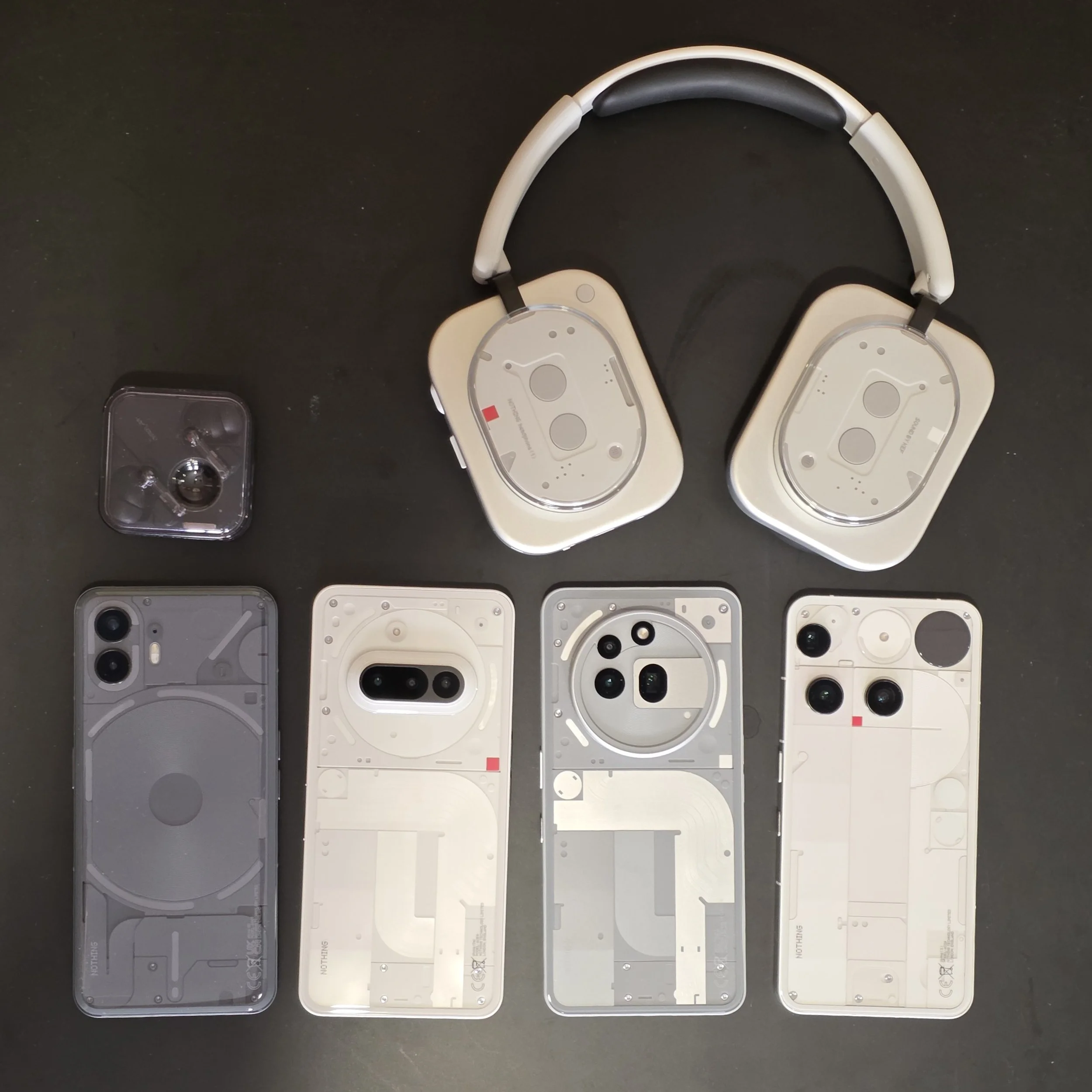Nothing Is Premium Now: Interview with CEO Carl Pei
Nothing has built a brand around attention-getting phones and earbuds with seemingly transparent designs and rear panel light shows. I spoke with CEO Carl Pei about Nothing’s attempt to move upmarket into flagship phones and premium headphones.
Context
Nothing is a London-based smartphone manufacturer that launched its first product, design-centric earbuds, back in 2022. It then proceeded to apply the transparent-but-not-really aesthetic to midrange smartphones and moved downmarket with a CMF subbrand. Some of the earbuds and phones were sold in the U.S., but most were spec’d and sold in India and Europe. Nothing’s first phones were priced aggressively but even its earliest phones stood out for attention to detail in software in addition to their faux transparent back panels, branded cables, and SIM tools. Nothing is now moving considerably upmarket with its first flagship smartphone, the $799 phone(3), and its first over-the-ear headphones, the $299 headphone(1).
The company’s CEO, Carl Pei, was a co-founder of BBK brand OnePlus, and he sat down with me for a conversation around Nothing’s brand strategy, competitive differentiation, and technology. Like all companies selling smartphones in the U.S. we talked about the challenges of distribution in the U.S. vs other markets, and like all consumer electronics companies we touched on how Nothing is dealing with geopolitics and tariffs.
When describing Nothing’s product plans, Carl focused on improving hardware, building expanding distribution, and investing in software, particularly AI implementation.
Unique design was the fastest way to get to market differentiation, but it’s not enough to compete with Apple, Samsung, and, in China, Huawei. As Nothing moves to establish its brand outside the low end and midrange, it is deliberately not undercutting the competition on price; long term, Nothing needs reasonable margins both to compete for customers with better products, and also to compete for the talent needed to design them.
To improve margins, Nothing also needs to grow in the U.S., a market which skews heavily towards the top end of price ladder. The U.S. is Nothing’s biggest market for earbuds already, but not for phones (that would be India, where average phone prices are much lower). The challenge is twofold: iPhone lock-in is strongest in Apple’s home market – green vs blue bubbles is a real issue among U.S. teens. Also, the super-premium phones that allow rich margins for R&D and brand investment are financed and often subsidized by U.S. carriers who have strong control over the distribution channel. Nothing does have one critical advantage: carriers would like alternatives to the current Apple-Samsung duopoly, but Chinese phones are subject to regulatory pushback if not outright bans. Nothing is based in London, and its U.S.-bound phones can be manufactured outside of China to potentially route around tariffs. Carrier certification for U.S. networks is fairly expensive, and carriers often have minimum sales requirements, so before Nothing makes the jump to U.S. carrier distribution, it needs to generate significant demand.
Nothing does not expect to ever have the funds to compete marketing dollar-for-dollar with Apple or Samsung, so it is focusing more on community. This goes beyond lip service and fan meetups; a fan representative is on Nothing’s board of directors, and Nothing has produced fan editions of some of its phones actually designed with input from the community, unlike Samsung’s “FE” devices which are just spec’d differently to hit a lower price point. Community engagement is a great way to bootstrap a brand, as Carl learned at OnePlus, which started out with a direct-to-consumer business model. However, fans can turn on you, and even managed well it can only get a brand so far. The products need to be different enough to attract a user base in the first place, a community is a great way to advocate for a brand but typically isn’t big enough to generate mainstream sales numbers, and even the hardest core fans will only stick around if the products remain competitive. Nothing’s specific challenge will be growing the brand from design-conscious value seekers who bought the company’s first products to design-conscious mainstream consumers willing to pay full price for premium products.
Phone(3)
Nothing is not making that transition easy for its community with its first flagship, the phone(3), which costs as much as a Samsung Galaxy S25 and Apple iPhone 16, but makes some tradeoffs. The phone(3) has a better display than Apple and a bigger one than Samsung, a much bigger battery than either, and large modern camera sensors. It also has the unique Nothing design language around back, along with a new glyph mini display and touch sensor for programmable widgets. Battery life is fantastic – this is a full-day phone for heavy users and a two-day phone for lighter workloads.
Nothing’s minimalist icon pack and widgets are entirely optional during setup, but they add a nice layer of intentionality to how you use your phone by draining color from icons. AI functionality is a big part of Nothing’s software direction. The company is not planning on building its own models, just finding better ways to use them. That’s everyone’s strategy, and this sounds most like Motorola, with a bit of OnePlus spin. That said, nobody is making this work yet. The closest is Samsung, and that’s just because they’re leaning even more heavily into Google’s Gemini. The big feature on the Nothing phone(3) is Essential Space, which is a way to store screenshots for AI to mine for data. Nothing dedicates a hardware button to the experience. I did not find this all that useful when I intentionally tried it – there are relatively few things the AI is capable of doing with the information at present, and images are processed in the cloud, not on the device. Worse, I found myself accidentally invoking it far too often; that button needs to be remappable. Nothing is promising 5 years of OS upgrades and 7 years of security. That slightly lags Google and Samsung but, more importantly, both of those companies have been in existence for more than seven years already, while Nothing …hasn’t.
However, Nothing’s image processing lags the competition at, and in some cases, below this price point. A software update cured the tearing I noticed on some photos I took, and the camera hardware does allow more detail in some wide-angle shots. However, the main and telephoto images don’t match a Pixel, Galaxy, iPhone, or Xiaomi, especially in challenging lighting.
To save money, Nothing is using Qualcomm’s Snapdragon 8s Gen 4, which offers fine performance, but can’t match the Snapdragon 8 Elite in the OnePlus 13 (currently priced at $829), the overclocked version in the Galaxy S25, or the Apple A18 in the iPhone 16. This absolutely should not matter to mainstream consumers, but it does matter to the type of value-oriented enthusiasts who bought earlier Nothing phones. Cost-cutting is also apparent in the grade of Corning Gorilla Glass used Nothing has abandoned its LED lighting gimmicks on the phone(3) in favor of the dot matrix glyph display, which has upset some fans. I actually find the new glyph display more usable – I typically have it act as a clock – and fun – I show off the Magic Eight Ball applet as my go-to demo. One common complaint I fully agree with: the off-center telephoto lens just looks wrong. (I asked Carl why they did this, and he defended his designers’ choices. In other words, it’s different to be different.)
The phone(3) is a solid phone that can be charming, and at a lower price it would be easy to recommend. At current pricing, the phone(3) isn’t a strong enough value to move Nothing’s existing customer base to upgrade and isn’t competitive enough to pull mainstream customers away from Apple or Samsung. Hopefully there will be a large enough pool of buyers in Europe who prioritize battery life and unique aesthetics over more mainstream and cheaper Chinese options, but it is hard to see the phone(3) selling in large numbers in the U.S. outside the carrier channel.
Headphone(1)
The story with the headphone(1) is happier: Nothing is still competing with large brands like Bose, Sony, Apple, and Apple’s Beats, but at $299 Nothing is priced below the most expensive ANC rivals. It also has an utterly unique look among a sea of rounded monochrome alternatives. The transparent Nothing design here is polarizing, especially since the speaker pods look like a cassette tape resting atop a metal box. Reviewers tend to love it or hate it. Personally, I don’t like the look, but as an analyst, I love it – that differentiation is crucial to cutting through the noise of the market.
Reviewers have been extremely kind to Nothing on comfort; I find the clamping force too heavy for my size-Large-hat head, but the weight of the headphones themselves is OK.
Nothing has made a big deal of its collaboration with UK speaker company KEF. I’m a fan of KEF’s LS50 home theater speakers; they were on my short list for Techsponential’s reference theater/lab. However, there isn’t much crossover between the Uni-Q coaxial driver array in a speaker box and a single, 40mm headphone driver. Furthermore, KEF really does appear to have worked directly with Nothing on these headphones and tuned them …a bit boring. They sound fine, and Nothing’s software allows for endless customization, but out of the box they lack both bass kick and midrange depth.
Another area where the headphone(1) falls short of the best premium headphones is ANC. Nothing is able to mute some loud, low sounds, and I left it on for all of my testing. However, if ANC is a priority, it can make sense to spend more for more effective offerings from rivals. Nothing’s ANC is not as good at cancelling my office wall air conditioner as my HyperX gaming headphones, and it substantially trails the best Sony and Bose headphones for adaptive noise cancellation on planes and commuting. Nothing’s transparency mode sounds muddy and unnatural, and the microphone .
One area where the Nothing headphone(1) handily beats all comers is in its physical controls. There is no better designed headphone for knowing whether it is turned on or off (a switch, not a button), adjusting volume (a physically rotating cylinder), or skipping tracks (a toggle). I hope the competition takes notes.
Conclusion
Nothing’s growth as a startup in a mature market is nothing less than astonishing. It has sold millions of devices in the heart of the most competitive segments against Chinese manufacturers who have huge economies of scale. Nothing’s audio products have sold well even in Western markets by deftly combining fair prices, audio quality, and unique design language. However, Nothing needs to grow into higher margin market segments – and, ideally, U.S. carrier distribution – to fuel long term success. The phone(3) is a first imperfect step in that journey, and its new headphones should help continue the brand’s momentum while the company invests in imaging, AI, and community.
For Techsponential clients, a report is a springboard to personalized discussions and strategic advice. To discuss the implications of this report on your business, product, or investment strategies, contact Techsponential at avi@techsponential.com.






















